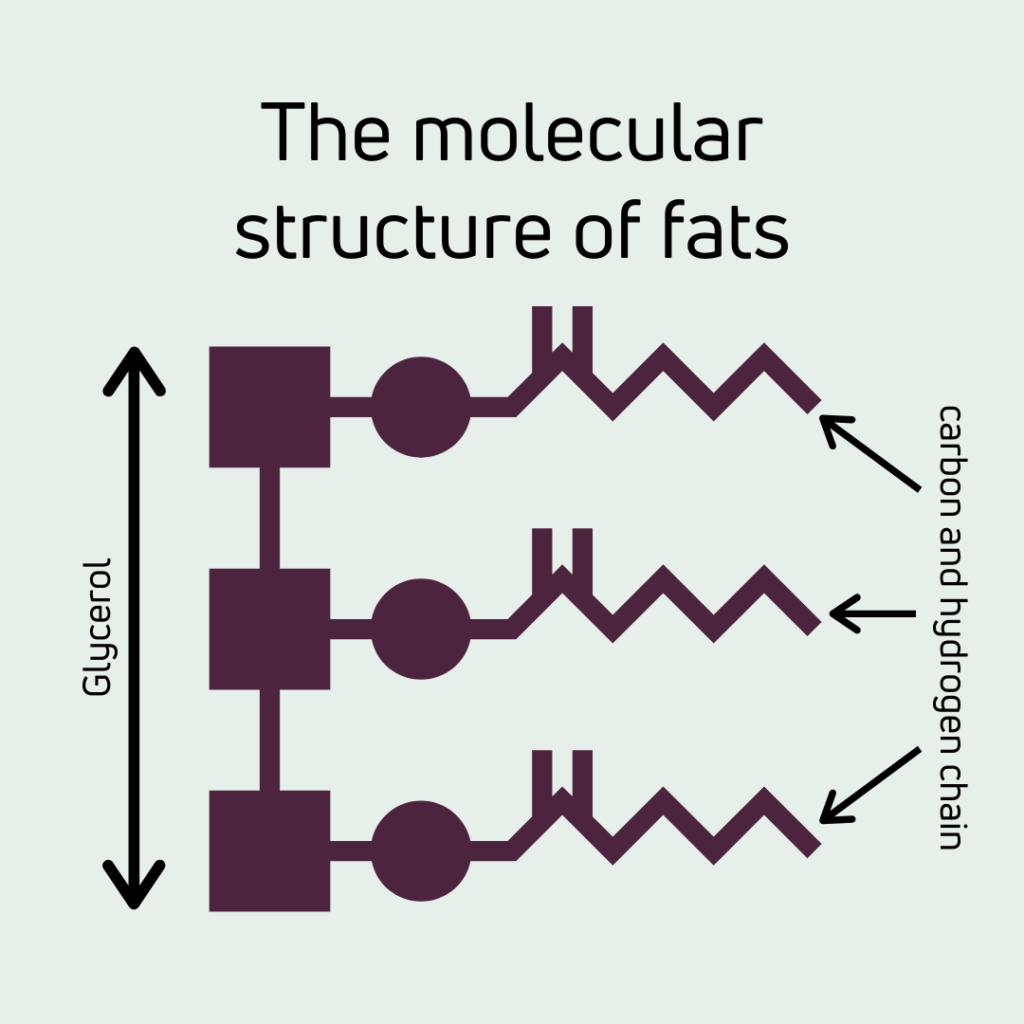Oils and fats are important ingredients in both the kitchen and in our diets. They give flavour to food and are important cooking mediums that allow us to cook food at high temperatures. Along with proteins and carbohydrates, oils and fats (which I will collectively call fats) are a macronutrient – a basic building block in our diet – and provide much of the energy we need. They are also important for the absorption of fat-soluble vitamins and for the formation of certain hormones.
Basically, fats don’t deserve the bad rap they have gotten and completely avoiding them is definitely not recommended. Read on to find out which fats are best for you.

Oils vs. fats
Chemically, oils and fats are part of the same family of molecules called lipids, which is characterized by its inability to mix with water (lipids are hydrophobic). The fats and oils you find in your kitchen are in the molecular form of a triglyceride – they have three long chains of carbon and hydrogen atoms, linked by another molecule called glycerol. Why is this important? The structure of fats and oils gives them their unique cooking and nutritional properties.

Although fats and oils have the same structure, they differ in their source and composition. Fats, like butter and lard, come from animal sources, are mostly composed of saturated fats, and are solid at room temperature. Oils come from plants, are mostly composed of unsaturated fats (with the exception of palm and coconut oils), and are usually liquid at room temperature.
Saturated vs. unsaturated fats
Whether a fat is saturated or unsaturated depends on the chemical structure of its carbon and hydrogen chains. Saturated fats have as many hydrogen atoms on them as they can possibly store. This many hydrogen atoms makes the hydrogen-carbon chain straight, allowing it to “stack”, which means saturated fats tend to be solid at room temperature (like butter and lard).
Unsaturated fats have less hydrogen atoms on them, which causes “kinks” in the chain, making it not completely straight. When there is just one of these “kinks”, the fat is considered monounsaturated. If there are multiple, it is polyunsaturated. The bends in these molecules make it hard for them to stack on each other, which makes unsaturated fats liquid at room temperature (like olive and canola oil).
Keep in mind, however, that saturation comes in degrees. No fat or oil is all saturated or unsaturated, because each one contains many varying types of fat molecules. Therefore, when we talk about a food like butter or olive oil, they are not completely saturated or completely unsaturated, but they are saturated by degrees. Oils, for example, contain mostly unsaturated fats. Take a look at the table below for a visual of the degree of saturation of different fats and oils.

Oils and Fats in Our Diet
Fat has often been vilified in popular culture as the cause of health problems like heart disease and obesity. But this bad rap is not necessarily deserved – many types of fats are actually heart-healthy and make up an important part of our diet. As previously mentioned, fats help us absorb certain vitamins, specifically vitamins A, D, E and K. Fat is used by our body to make hormones, protect our organs, and to keep us warm.
Fats and heart health
Some types of fats, like monounsaturated and polyunsaturated fats, are good for our health. These are usually found in oils, such as olive and canola oil, and can help lower bad cholesterol and increase good cholesterol. On the other hand, most animal-based fats like those in butter, meat, and cheese are made up mostly of saturated fats, which tend to be bad for one’s health. They may increase bad cholesterol and are linked to heart disease.
Research shows that replacing foods that contain saturated fat with foods that contain unsaturated fat may reduce the risk of heart disease. In practice, this means choosing plant-based foods more often than animal-based foods. For example, it’s best to cook with an oil like canola, vegetable, or olive oil, rather than with butter. This doesn’t mean that foods that contain saturated fat should be avoided altogether, but rather that they should be enjoyed in moderation!
Trans fats
Trans fats are unsaturated fats, but unlike monounsaturated and polyunsaturated fats, their long chains are straight. So they do not contain all of the hydrogen atoms they can carry, but because of a different configuration of bonds, they are straight and solid at room temperature. This makes them perfect for use in the food industry, in food products like hydrogenated margarines and baked goods.
Trans fats increase cholesterol and the risk of heart disease. Nowadays, most governments have taken steps to force the food industry to eliminate trans fats from our food supply, so most foods in the grocery store do not contain high levels of trans fats.
Omega-3 fats
Omega-3 fats are a type of polyunsaturated fat. You can find them in some vegetable oils, including soybean, canola, flaxseed, and walnut. They are also present in animal products like omega-3 enriched eggs, grass-fed beef, fish, and fish oil. These types of fats are essential fatty acids, meaning that our body can’t make its own and we must get them from our diet.
Omega-3 fats are used in our bodies for many things, including to form cell membranes, especially in the eyes and brain, as signalling molecules, and as an energy source. Omega-3 fats have also been found to have anti-inflammatory properties.
Don’t be fooled, however, by companies marketing Omega-3 supplements as a panacea. In North America, it is virtually unheard of for someone to have a deficiency in essential fatty acids, so you are mostly likely already getting enough. Also, research has found that higher intake of omega-3 rich foods, especially fish, as part of a balanced diet is linked to better health outcomes like heart health. There is also some evidence that omega-3 intake may help lower triglycerides (a type of fat in the blood linked to heart disease). So, the best thing to do is to get your omega-3 from food, especially by adding fish to your diet. If you’re vegetarian, there are vegetarian options as well. Only add a supplement if it recommended by your doctor.
What’s the deal with coconut oil?

Coconut oil has been marketed as a health food, with touted benefits including cancer prevention and treatment, reduction of inflammation, and anti-aging properties. Science does not support these claims. In fact, coconut oil is actually made up mostly of saturated fats and has been shown to increase cholesterol levels when compared to vegetable and olive oils. So, it is actually recommended to use other oils that are high in unsaturated fats rather than coconut oil. Of course, if you enjoy using coconut oil, you can go ahead, but treat it the way you’d treat butter – consume in moderation!
Choosing oils for cooking
Many people are confused about choosing the right oil to cook with. For starters, it’s best to follow the recommendations above and choose oils that are high in unsaturated fats and low in saturated fats.
It’s also important to consider the oil’s smoke point. The smoke point is the temperature at which the oil stars to decompose, which leads to a loss of flavour and the creation of some unpleasant substances that may be bad for your health. All oils and fats have different smoking points. It’s beyond the scope of this article to discuss them all, but you can easily google your chosen oil to find out. Keep in mind the following average cooking temperatures when doing so:
- Sautéing and frying – 350-450°F/ 175-225°C
- Oven/baking – 300-500°F/ 159-260°C
So as a general rule, choose an oil with a smoke point that is higher than the temperature you’re planning to cook it at. That way, it doesn’t reach the smoke point. Personally, I opt to sauté and stir fry with canola, vegetable, or light olive oil, all of which have a high smoke point. I choose to make my salads with extra virgin olive oil, because it has a low smoke point and retains its flavour best when not cooked at all.
Oils and fats: the bottom line
- Choose an oil that contains monounsaturated and/or polyunsaturated fats
- These help lower bad cholesterol and raise good cholesterol
- Limit oils that contain saturated and trans fats
- These increase your risk of heart disease
A word on vinegars
Unlike fats, vinegars do not provide much energy or nutrients but rather add flavour to our food. Vinegar is mostly made up of water, along with some acetic acid and other flavour components. It is made when bacteria convert alcohol from ingredients such as grapes, grains, rice, or apples into acetic acid. The acetic acid gives the vinegar its distinctive sour taste.
Nutritional properties of vinegar
There has been some media buzz regarding the beneficial nutritional qualities of certain vinegars, especially apple cider vinegar, and their abilities to treat a while array of conditions. However, there is little scientific evidence to back up any of these claims. Vinegar contains very little nutrients.
My suggestion? Add vinegar to your food if you like it. It adds a nice brightness to dishes and is a great low-calorie addition to foods like salad dressings. Vinegar can also be used to tenderize meat and to pickle vegetables.
Oil and vinegar based recipes
References
- American Heart Association. (2020). Dietary Fats. Retrieved from https://www.heart.org/en/healthy-living/healthy-eating/eat-smart/fats/dietary-fats.
- Harvard T. H. Chan School of Public Health. (2020). Vinegar. The Nutrition Source. Retrieved from https://www.hsph.harvard.edu/nutritionsource/food-features/vinegar/#:~:text=Nutrients,contain%20trace%20amounts%20of%20nutrients.Khan Academy. (2020). Lipids. Retrieved from: https://www.khanacademy.org/science/biology/macromolecules/lipids/a/lipids.
- McGee, H. (2004). On Food and Cooking: The Science and Lore of the Kitchen. Scribner.
- National Institutes of Health. (2019). Omega-3 Fatty Acids: Fact Sheet for Health Professionals. U.S. Department of Health & Human Services. Retrieved from https://ods.od.nih.gov/factsheets/Omega3FattyAcids-HealthProfessional/.
- Sacks, F. M., Lichtenstein, A. H., Wu, J., Appel, L. J., Creager, M. A., Kris-Etherton, P. M., Miller, M., Rimm, E. B., Rudel, L. L., Robinson, J. G., Stone, N. J., Van Horn, L. V., and the American Heart Association. (2017). Dietary Fats and Cardiovascular Disease: A Presidential Advisory From the American Heart Association. Circulation, 136(3), e1-e23. https://doi.org/10.1161/CIR.0000000000000510.
